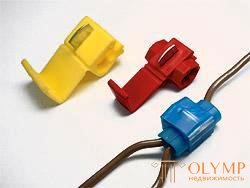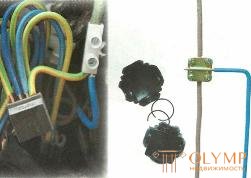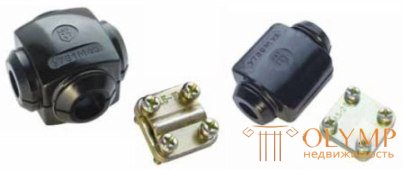
 Very often, electricians have to connect the electrical installation to an existing line passing by in relative proximity. In other words, it is necessary to create a branch cable .
Very often, electricians have to connect the electrical installation to an existing line passing by in relative proximity. In other words, it is necessary to create a branch cable .
An example would be the connection of a private house to a 0.4 kV overhead line or the connection of an apartment switchboard to access electrical risers. In both of these cases, the line passes, perhaps very close - here they are, the cherished 220 or 380 volts with the necessary power reserve, you can reach them by hand. But how to connect to them?
Since this problem is widespread and well known for a long time, there are already quite a lot of options for its solution, and in this article we will try to consider them in detail.
The very first way to create a branch that comes to mind is a good old twist. There is no need to be wise - if the wire is insulated (CIP, for example), then it is stripped at the point of contact, and the branch line is wound onto it with a large number of turns to ensure a large contact area.
Of course, the one who decided to twist, will have to reckon with the fact that:
- in the book, which is sacred for every electrician, - PUE - they speak of twisting extremely disapprovingly and practically anathematize them. Therefore, the electrician who performs the twist assumes increased responsibility;
- twisting is possible only if the material of the wire of the trunk and branch line is the same. That is, copper - to copper, aluminum to aluminum. Otherwise, twisting will not last long and can cause the most serious problems;
- twisting should be done if you are sure that you will make it well and efficiently. If you doubt your experience and qualifications - use special clasps or pads .

Fig. 1. Universal branch terminal block DKS
Pads approved by PUE. But there is also a few "but." First, for the application of the terminal block, the main wire must be cut. This is completely undesirable. Secondly, the terminal block is a screw connection that requires systematic maintenance and contact drawing.
This is also not very convenient. Well and, thirdly, the terminal strip is practically not protected by precipitation or mechanical effects. In short, the reliability of the junction terminal block is very low. Therefore, it is better to use branch clamps .
And such clips are available in a fairly large assortment. The most popular among them are the so-called "nuts" . Their construction is as follows: the trunk and branch wires are pressed from different sides to the contact die made of anodized steel with the help of four screws and plates with grooves. This whole “sandwich” is closed by a carbolite body, which is tightened with two spring rings.

Fig. 2. Branching clamps ("Nuts")
Marking "nuts" includes the letter "U" and a three-digit item number. Nuts are good because they allow you to connect aluminum and copper wires, since the design of these clips prevents their direct contact - the steel die is a "mediator". In addition, for connecting nuts, the main wire does not need to be cut, and the cross-section of the connected wires can be very different: from 4 to 150 square meters. mm for the main wire and from 1.5 to 120 square meters. mm for branch out.
“Nuts” is, of course, good, but I would like more. In particular, it is not very convenient that they need to be stripped of insulation to connect the wires. And it is not that inconvenient to mount “nuts” under voltage - it is simply dangerous. In addition, the degree of protection against squeezing the “nut” against external influences often leaves much to be desired - only IP20. The deficiencies cited lack piercing clamps . These clips are sealed, do not require stripping of the main wire, and therefore do not impair its performance. The whole secret is in special clamping plates with teeth that can pierce the insulation and ensure electrical contact with the wire. |
The tightening force of the compression bolts is regulated by a shear hex head, hence the piercing clamps are intended for single use. The heads of the clamping bolts are electrically insulated from the contact plates, so the installation of these clamps can be done even under voltage. Most often, these clips are used for mounting overhead lines with SIP wire.

Fig. 3. The tight puncturing clip of ZPO
When installing branch lines in a workshop or residential building, it may be more logical to use an OB-type clamp. They too could be called “piercing”, and their application does not require any tools or special skills at all.
Connect the wires without stripping the insulation are placed in the clip, which just snaps hands. At the same time the brass connector pierces the insulation of wires and provides a reliable electrical connection. However, OM connect copper and aluminum wires with a maximum cross section of only 6 square meters. mm., besides the cross section of the main and branch wires should be about the same, so they are not used very often.

Fig. 4. Wire coupler type OB
The considered devices for performing the tap-offs cannot be unambiguously classified into “best” and “worst”. Under a specific situation, the task and the object fits a certain branching contraction, and the electrician is obliged to correctly select it. Then the branch will last long and reliably.
 Very often, electricians have to connect the electrical installation to an existing line passing by in relative proximity. In other words, it is necessary to create a branch cable .
Very often, electricians have to connect the electrical installation to an existing line passing by in relative proximity. In other words, it is necessary to create a branch cable .
An example would be the connection of a private house to a 0.4 kV overhead line or the connection of an apartment switchboard to access electrical risers. In both of these cases, the line passes, perhaps very close - here they are, the cherished 220 or 380 volts with the necessary power reserve, you can reach them by hand. But how to connect to them?
Since this problem is widespread and well known for a long time, there are already quite a lot of options for its solution, and in this article we will try to consider them in detail.
The very first way to create a branch that comes to mind is a good old twist. There is no need to be wise - if the wire is insulated (CIP, for example), then it is stripped at the point of contact, and the branch line is wound onto it with a large number of turns to ensure a large contact area.
Of course, the one who decided to twist, will have to reckon with the fact that:
- in the book, which is sacred for every electrician, - PUE - they speak of twisting extremely disapprovingly and practically anathematize them. Therefore, the electrician who performs the twist assumes increased responsibility;
- twisting is possible only if the material of the wire of the trunk and branch line is the same. That is, copper - to copper, aluminum to aluminum. Otherwise, twisting will not last long and can cause the most serious problems;
- twisting should be done if you are sure that you will make it well and efficiently. If you doubt your experience and qualifications - use special clasps or pads .

Fig. 1. Universal branch terminal block DKS
Pads approved by PUE. But there is also a few "but." First, for the application of the terminal block, the main wire must be cut. This is completely undesirable. Secondly, the terminal block is a screw connection that requires systematic maintenance and contact drawing.
This is also not very convenient. Well and, thirdly, the terminal strip is practically not protected by precipitation or mechanical effects. In short, the reliability of the junction terminal block is very low. Therefore, it is better to use branch clamps .
And such clips are available in a fairly large assortment. The most popular among them are the so-called "nuts" . Their construction is as follows: the trunk and branch wires are pressed from different sides to the contact die made of anodized steel with the help of four screws and plates with grooves. This whole “sandwich” is closed by a carbolite body, which is tightened with two spring rings.

Fig. 2. Branching clamps ("Nuts")
Marking "nuts" includes the letter "U" and a three-digit item number. Nuts are good because they allow you to connect aluminum and copper wires, since the design of these clips prevents their direct contact - the steel die is a "mediator". In addition, for connecting nuts, the main wire does not need to be cut, and the cross-section of the connected wires can be very different: from 4 to 150 square meters. mm for the main wire and from 1.5 to 120 square meters. mm for branch out.
“Nuts” is, of course, good, but I would like more. In particular, it is not very convenient that they need to be stripped of insulation to connect the wires. And it is not that inconvenient to mount “nuts” under voltage - it is simply dangerous. In addition, the degree of protection of the nut squeeze against external influences often leaves much to be desired - only IP20.
The above deficiencies are devoid of piercing clamps . These clips are sealed, do not require stripping of the main wire, and therefore do not impair its performance. The whole secret is in special clamping plates with teeth that can pierce the insulation and ensure electrical contact with the wire.
The tightening force of the compression bolts is regulated by a shear hex head, hence the piercing clamps are intended for single use. The heads of the clamping bolts are electrically insulated from the contact plates, so the installation of these clamps can be done even under voltage. Most often, these clips are used for mounting overhead lines with SIP wire.

Fig. 3. The tight puncturing clip of ZPO
When installing branch lines in a workshop or residential building, it may be more logical to use an OB-type clamp. They too could be called “piercing”, and their application does not require any tools or special skills at all.
Connect the wires without stripping the insulation are placed in the clip, which just snaps hands. At the same time the brass connector pierces the insulation of wires and provides a reliable electrical connection. However, OM connect copper and aluminum wires with a maximum cross section of only 6 square meters. mm., besides the cross section of the main and branch wires should be about the same, so they are not used very often.

Fig. 4. Wire coupler type OB
The considered devices for performing the tap-offs cannot be unambiguously classified into “best” and “worst”. Under a specific situation, the task and the object fits a certain branching contraction, and the electrician is obliged to correctly select it. Then the branch will last long and reliably.
Что бы оставить комментарий войдите
Комментарии (0)